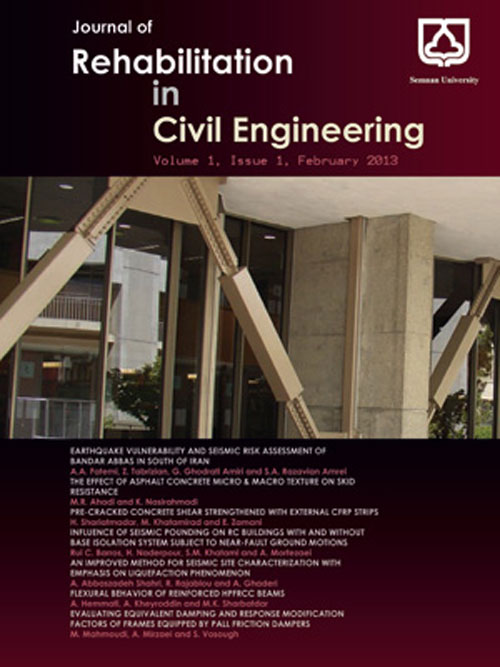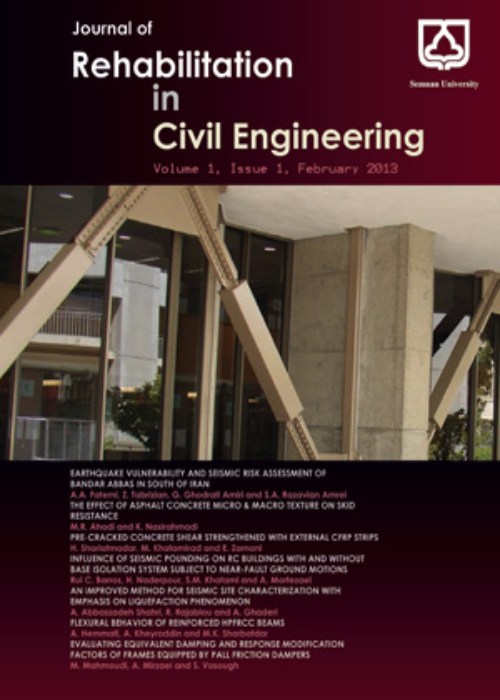فهرست مطالب

Journal of Rehabilitation in Civil Engineering
Volume:5 Issue: 2, Summer - Autumn 2017
- تاریخ انتشار: 1396/05/25
- تعداد عناوین: 7
-
-
Earthquake induced Deterministic Damage and Economic Loss Estimation for Kolkata, IndiaPages 1-24The city of Kolkata, the State Capital of West Bengal is jolted by earthquakes time and again from the tectonic regimes of the Central Himalaya, highly seismogenic Northeast India and the active tectonics of Bengal Basin which is a pericratonic tertiary basin on which the City is located. Earthquake disaster mitigation and management necessitates seismic hazard assessment for the generation of design response spectra at a site of interest with a zone factor for the computation of seismic coefficient to be adapted in building codes. The surface consistent probabilistic seismic hazard model of Kolkata for 475 years of return period have been used for modeling of damage potential of buildings, human casualty and economic loss employing the widely used SEismic Loss EstimatioN using a logic tree Approach (SELENA) in a relational analysis protocol considering eleven model building types. The demand spectrum curve of a spectral acceleration through a judicious interaction with the building capacity curve and fragility curve yields the damage state probability of the same in terms of slight, moderate, extensive and complete. Human casualty levels are also computed using SELENA for three different times of the day viz. Night, Day and Commuting time. The economic loss to the tune of ~231 billion of Indian Rupees due to building damage only have been estimated within 300 socioeconomic clusters in the City. It is expected that this model will go a long way in safe urbanization process with well-defined disaster mitigation and management guidelines for the city of Kolkata.Keywords: Seismic hazard, Damage, Casualty, Economic Loss, SELENA
-
Pages 25-38Earthquake force, loading more than structural capacity, cracking, material fatigue and the other unpredicted events were undeniable in the structure life cycle in order that environmental conditions of the structure would be changed and treats health. Damage of structures such as crack, corrosion of the post tension cables from inappropriate grouting of the post tension structures and etc. can lead to the collapse of the structure. So, damage detection precedes the damage is important. In this study damage detection in the post-tensioned slab through 2D wavelet transform investigated. For this purpose, the structure has been modeled with finite element method. Damaged cables have been modeled by decreasing the post tension force. The vertical displacement has been derived through static analysis of intact and damaged structure. Damage location will be detected with wavelet transform on the difference of the vertical displacements. To demonstrate the ability of 2D wavelet transform single and multiple scenarios of the post tension cables, are tested. The influence of noise in the vertical displacement data for these scenarios is also considered. Using 2D wavelet transform and damage index W, an empirical equation has been proposed to calculate damage severity of the post-tensioned slab cables.Keywords: Damage detection, Signal Processing, 2D wavelet transform, Post-tensioned slab
-
Pages 39-51This paper investigates the integrated riser/vessel system which is subjected to random waves. Riser pipelines are the main components of the oil and gas offshore platforms. Whereas Iran country has been located on the fringes of Caspian Sea deep water, therefore study and research in this area is increasingly essential. The fluctuation of floating production causes the severe response and greatest fatigue damage near the Touchdown Point (TDP) where the Steel Catenary Riser (SCR) first touches the seabed. Therefore, analysis the response of SCRs in the TDP is very important to approximate the behavior of the riser. In this study, initially, the structural parameters (wall thickness and diameter) according to design codes due to the severe climatic conditions are obtained. In the next step, Pipe-soil interaction is modelled using a linear model in the vertical direction and Coulomb friction models in the lateral direction. Also, the significance of SCR-seabed interaction in the global response of riser pipeline at TDP when subjected to random waves on soft clay is analyzed based on the Caspian Sea environmental conditions. A fully three-dimensional non-linear time domain finite element program with a robust meshing technique has been applied to simulate the arbitrarily large deflections of the flexible from the initial configuration by using the commercial software OrcaFlex.Keywords: steel catenary riser, touchdown point, linear seabed model, lateral soil resistance, Riser-seabed interaction
-
Pages 58-76Fiber reinforced polymer (FRP) material is currently being produced in different configurations and widely used to strengthen and retrofit concrete structures and bridges. It is also possible to apply other strengthening methods without changing the appearance or the dimensions of the structure. Near Surface Mounted (NSM) is a recent strengthening method using CFRP bars (rods or laminate strips) bonded into pre-cut grooves applied to the concrete cover of the elements to be strengthened. These FRP bars can also help increase flexural and shear capacity of existing concrete members. This paper aims to present the experimental and numerical results gained separately from un-strengthened and strengthened beams under bending loading. In the experimental part, two large-scale fixed-end support reinforced concrete beams of the same size and reinforcement characteristic were designed, constructed, and tested under one point concentrated loading system. The first specimen used as a control specimen while the second served as the strengthened using NSM method with a new proposed hand-made CFRP Bar in the laboratory. Moreover; an extra analytical work was carried out using calibration of the analytical models as per the obtained experimental test results. The results and Photographs taken at the selected stages of loading are indicative of the fact that NSM method with FRP bars can be effectively applied to the existing structures in order to increase their flexural capacity, change their crack pattern and decrease final deflection.Keywords: NSM Method, FRP Bars, Flexural capacity, RC beam, Strengthening
-
Pages 77-92In this paper the damage location in beam like-structure is determined using static and dynamic data obtained using finite volume method. The change of static and dynamic displacement due to damage is used to establish an indicator for determining the damage location. In order to assess the robustness of the proposed method for structural damage detection, three test examples including a static analysis, free vibration analysis and buckling analysis for a simply supported beam having a number of damage scenarios are considered. The acquired results demonstrate that the method can accurately locate the single and multiple structural damages when considering the measurement noise. Finite volume method results provided in this study for finding the damage location is compared with the same indicator derived via finite element method in order to evaluate the efficiency of FVM. The acquired results are showed a good match between both Finite Volume method and Finite Element method and there are reasonable correlations between ones.Keywords: Damage detection, Static, dynamic noisy data, Finite Element Method, Buckling analysis, Displacement based indicator
-
Recent Trend Determination of groundwater level along with inter-reliant hydrologic components using Mann-Kendall Test,Linear Regression& Geometrical Progression: A case study for Bogradistrict in BangladeshPages 90-98Groundwater, a special hydrological variable and freshwater resource is completely inter-reliant with hydro-metorological, topographic, land use and hydro-geological components of hydrologic cycle. Trend of hydrologic componentsfor future prediction is attempted to confer in this study using Man-Kendall test, linear regression and geometric progression analysis on recorded data collected from recognize organization of Bangladesh. Bogra district is selected as the study area, which is characterized for fluctuating hydrological components over the years. Temporal distribution & recent trend of dominating hydrologic variables are analyzed and spatial distribution map is presented to discuss localize disparity within the study area. Groundwater abstraction & corresponding recharge reliant with hydro-meteorology and hydro-geology along with land use pattern is attempted to understand in this research. Study conclude for all hydological components related with groundwater is depleting over the recent years with the increase use of water specially for irrigation and domestic needs, but distribution is uneven throughout the Bogra district.Keywords: Groundwater, Rainfall, Irrigation, Hydrologic time series, Trend analysis
-
Pages 99-111For rehabilitation of damaged concrete structures, the durability of repair overlay is a very important issue. Self-compacting concretes (SCC) are known as a suitable repair overlay materials. In this study, the durability of different self-compacting lightweight aggregate concretes (LWSCC) and effect of lightweight aggregate type on them is investigated. 3 mix designs of LWSCC containing three different types of lightweight aggregates and a conventional self-compacting concrete were considered. The Rapid chloride permeability tests (RCPT), Rapid chloride migration tests (RCMT) and Accelerated corrosion tests (ACT) were performed and the Chloride migration coefficients were obtained. The corrosion resistance of the mix designs was investigated and compared. The classification of the concrete resistance against chloride penetration for all lightweight Mixes were acceptable but concrete with Leca and Pumice had the best and the worst performance respectively. As a result of using lightweight aggregates, using Scoria aggregate may cause better protection to steel reinforcement against corrosion than Leca and Pumice aggregate.Keywords: Durability, Light Weight SCC, RCPT, RCMT, Accelerated Corrosion Test


